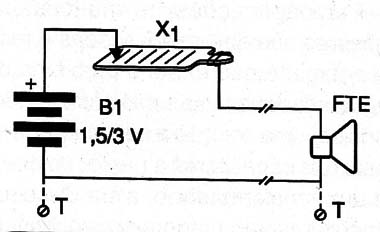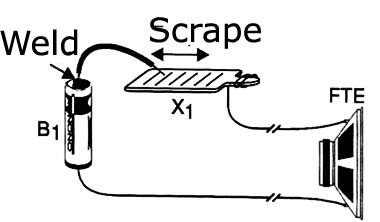An old speaker, one or two batteries (even weak), a file and wires is all the reader needs to put together in a telegraphic system.
Every shaved wire on file in X1, which is the telegraph key, when touched makes the speaker emits a signal. A long touch will be a dash and a short shaved a point.
Combining dashes and points according to the Morse code, we can send messages to distances up to 100 meters. Look for information on this site about the Morse Code.
The basic system has two wires, but you can save one wire if the points T are connected to ground, ie, two metal rods buried in the ground. In this case, the "return" signal will be made for the ground, which is conductive.
This saves wires, because we need only a one to connect the stations. In Figure 1 we have the complete diagram of the device.

In Figure 2 we have the real aspect of the assembly.

B1 may be formed by one or two small, medium or large cells. The speaker can be of any type and size.
The wire can be any thickness as long as isolated to prevent any losses. The file is of the flat type of any size.
To use, just rub the tip of the wire X1. There must be sound output from the speaker. Do not let the wire touching ont X1 when the appliance is not in use or without transmitting, as this will cause the batteries to run down.
B1 - 1 or 2 batteries - see text
X1 - File / wire - improvised handler
FTE - 4 or 8 Ω - speaker of any size
Miscellaneous:
Speaker, wires, weld, etc.




